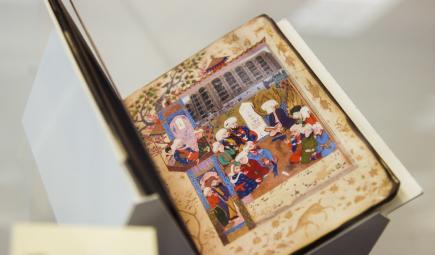Dialogues and Discourses: Talking about Tough Topics in Museums
Jul 06, 2021 | By Annie Hamaty
Do museums have a responsibility to ensure their research and collection practices support diversity, equity, accessibility, and inclusion (DEAI)? The panellists and participants of the virtual conversation, “Dialogues and Discourses: Talking about Tough Topics in Museums,” said yes.
The Smithsonian Office of International Relations (OIR) helped organize a moderated international discussion, which took place on May 17 and served as a follow-on to a Transatlantic Seminar that the Smithsonian Institution (SI) hosted in 2019. In 2019, SI, Germany’s Leibniz Association, and Fulbright Germany co-developed a four-day Transatlantic Seminar for 26 museum curators and educators titled “Museums as Spaces for Social Discourse and Learning”, hosted at the Smithsonian. The May 2021 virtual program speakers were Julie Garner (National Museum of American History, NMAH), Sarah Junk Hatcher (Indiana University), Frank Usbeck (State Art Collections Dresden), and Heike Zech (Germanisches Nationalmuseum), and Barbara Stauffer (National Museum of Natural History, NMNH) served as facilitator.
Speakers discussed topics including museum practices of collecting, interpreting, and connecting with underrepresented audiences. Attendees had the opportunity to interact in small groups in breakout rooms and were prompted to answer three questions:
• Which tough topics are your institution currently addressing?
• Who are you in dialogue with to address these topics?
• What are the challenges (if any)?
Some of the answers involved efforts of ethical practices of researching and collecting, while others touched on the importance of DEAI in their offices. One person of interest was Sarah Baartman, a South African woman whose remains were displayed in a Paris museum until 1974. Panelists and attendees also shared best practices and agreed that DEAI matters in museums.
Over 150 participants attended the panel from the United States, Germany, South Africa, Canada, Switzerland, and Ireland. Aligned with institutional efforts to increase accessibility, the panel offered sign language interpretation in German. Panelists and attendees felt the conversation was insightful and inspiring.
[[{"fid":"1810","view_mode":"wysiwyg","fields":{"format":"wysiwyg"},"type":"media","field_deltas":{"1":{"format":"wysiwyg"}},"attributes":{"class":"media-element file-wysiwyg","data-delta":"1"}}]]
Panelist Julie Garner, Theatre Specialist/Actor from NMAH stated, “The new connections and collaboration with colleagues from the US and Germany inspired academic discussion, creative solutions, and hope for a more inclusive relationship with a broader museum audience. Both our nations have complicated and inhumane histories, and it was enlightening to see the similarities and differences in how we grapple with those complexities both internally and with our audiences. The transatlantic conversations about DEAI, decolonization, and community-centered co-creation efforts confirmed that the Smithsonian has the momentum and resources to be both a leader and a learner in the global museum community.”
The Smithsonian looks forward to continuing to strengthen its relationship with the Leibniz Association and Fulbright Germany and serving as a safe space for difficult conversations to transform understanding.
Resources:
• Fulbright Germany website
• Leibniz Association website
• Recording link
• Fulbright Germany virtual conversation landing page




